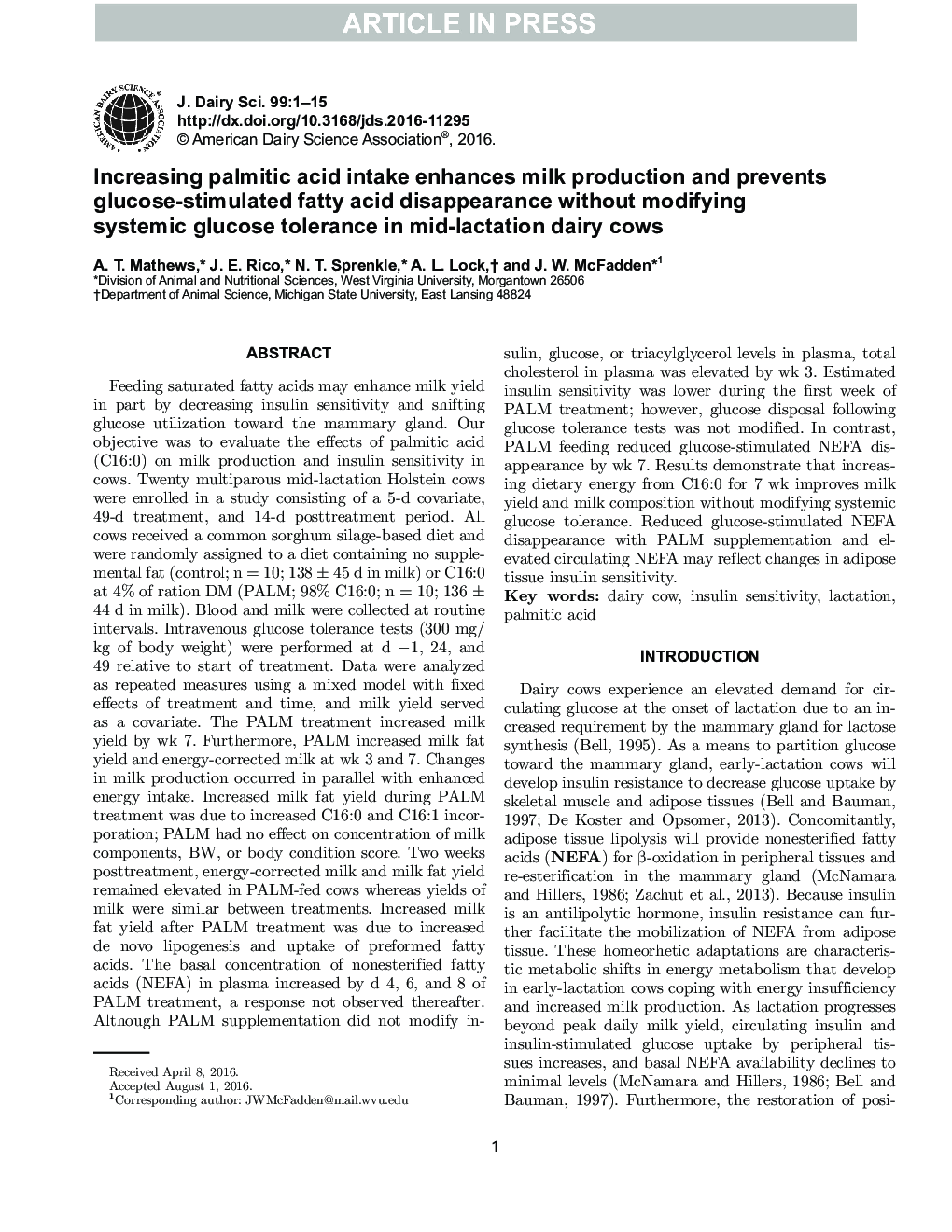| کد مقاله | کد نشریه | سال انتشار | مقاله انگلیسی | نسخه تمام متن |
|---|---|---|---|---|
| 5542655 | 1402521 | 2016 | 15 صفحه PDF | دانلود رایگان |
عنوان انگلیسی مقاله ISI
Increasing palmitic acid intake enhances milk production and prevents glucose-stimulated fatty acid disappearance without modifying systemic glucose tolerance in mid-lactation dairy cows
دانلود مقاله + سفارش ترجمه
دانلود مقاله ISI انگلیسی
رایگان برای ایرانیان
کلمات کلیدی
موضوعات مرتبط
علوم زیستی و بیوفناوری
علوم کشاورزی و بیولوژیک
علوم دامی و جانورشناسی
پیش نمایش صفحه اول مقاله

چکیده انگلیسی
Feeding saturated fatty acids may enhance milk yield in part by decreasing insulin sensitivity and shifting glucose utilization toward the mammary gland. Our objective was to evaluate the effects of palmitic acid (C16:0) on milk production and insulin sensitivity in cows. Twenty multiparous mid-lactation Holstein cows were enrolled in a study consisting of a 5-d covariate, 49-d treatment, and 14-d posttreatment period. All cows received a common sorghum silage-based diet and were randomly assigned to a diet containing no supplemental fat (control; n = 10; 138 ± 45 d in milk) or C16:0 at 4% of ration DM (PALM; 98% C16:0; n = 10; 136 ± 44 d in milk). Blood and milk were collected at routine intervals. Intravenous glucose tolerance tests (300 mg/kg of body weight) were performed at d â1, 24, and 49 relative to start of treatment. Data were analyzed as repeated measures using a mixed model with fixed effects of treatment and time, and milk yield served as a covariate. The PALM treatment increased milk yield by wk 7. Furthermore, PALM increased milk fat yield and energy-corrected milk at wk 3 and 7. Changes in milk production occurred in parallel with enhanced energy intake. Increased milk fat yield during PALM treatment was due to increased C16:0 and C16:1 incorporation; PALM had no effect on concentration of milk components, BW, or body condition score. Two weeks posttreatment, energy-corrected milk and milk fat yield remained elevated in PALM-fed cows whereas yields of milk were similar between treatments. Increased milk fat yield after PALM treatment was due to increased de novo lipogenesis and uptake of preformed fatty acids. The basal concentration of nonesterified fatty acids (NEFA) in plasma increased by d 4, 6, and 8 of PALM treatment, a response not observed thereafter. Although PALM supplementation did not modify insulin, glucose, or triacylglycerol levels in plasma, total cholesterol in plasma was elevated by wk 3. Estimated insulin sensitivity was lower during the first week of PALM treatment; however, glucose disposal following glucose tolerance tests was not modified. In contrast, C16:0 feeding reduced glucose-stimulated NEFA disappearance by wk 7. Results demonstrate that increasing dietary energy from C16:0 for 7 wk improves milk yield and milk composition without modifying systemic glucose tolerance. Reduced glucose-stimulated NEFA disappearance with C16:0 feeding and elevated circulating NEFA may reflect changes in adipose tissue insulin sensitivity.
ناشر
Database: Elsevier - ScienceDirect (ساینس دایرکت)
Journal: Journal of Dairy Science - Volume 99, Issue 11, November 2016, Pages 8802-8816
Journal: Journal of Dairy Science - Volume 99, Issue 11, November 2016, Pages 8802-8816
نویسندگان
A.T. Mathews, J.E. Rico, N.T. Sprenkle, A.L. Lock, J.W. McFadden,